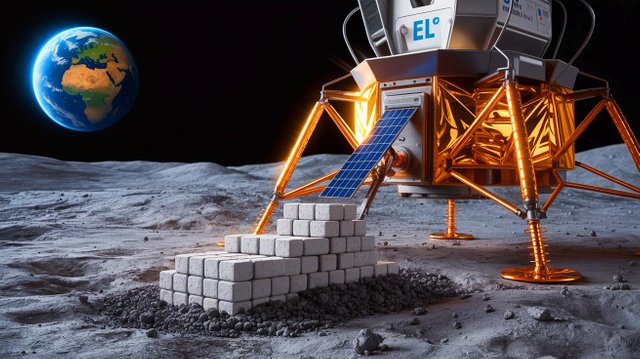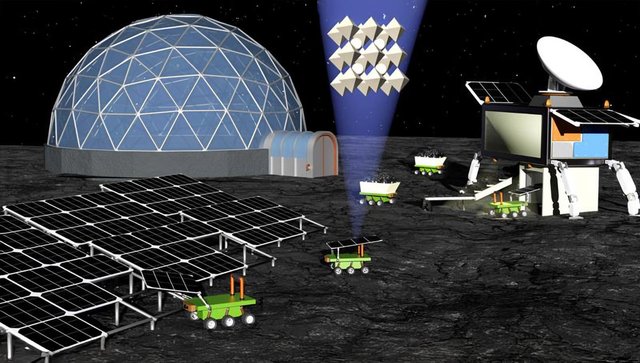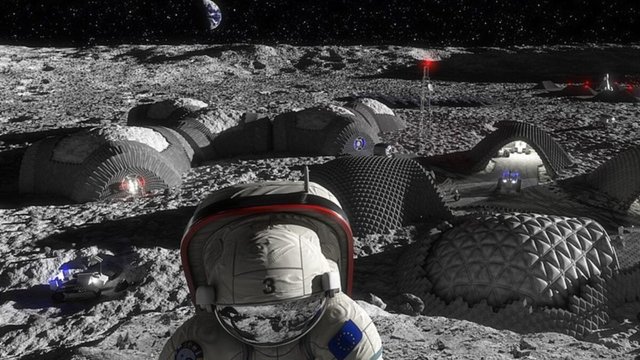Solar-powered device turns moon dust into bricks/Dispositivo a energía solar convierte polvo lunar en ladrillos

Source
Creating a human colony on Mars is a venture that, while perfectly viable, is still far from achievable, despite what Elon Musk says. But settlements on the Moon are getting closer to becoming a reality, our satellite is a much easier destination to reach, and it seems that the two major powers (China and the USA) have recently begun a new space race similar to the one we experienced in the second half of the last century between the USA and the former USSR.
Crear una colonia de humanos en Marte es una empresa que, aunque perfectamente viable, todavía está lejos de cumplirse, a pesar de lo que diga Elon Musk. Pero los asentamientos en la Luna están cada vez más cerca de hacerse realidad, nuestro satélite es un destino mucho más fácil de alcanzar y parece que últimamente las dos grandes potencias (China y USA), han comenzado una nueva carrera espacial parecida a la que vivimos en la segunda mitad del siglo pasado entre EEUU y la extinta URSS.
That's why new projects emerge every day that aim to adapt the Moon for our use and enjoyment. In today's case, a team of scientists from China's Deep Space Exploration Laboratory has developed a pioneering device that can make bricks from lunar dust using only solar energy. The system was designed as part of a project for the International Lunar Research Station (ILRS), with a view to building infrastructure on the Moon for long-term missions.
Por eso cada día surgen nuevos proyectos que pretenden acondicionar la Luna para nuestro uso y deleite. En el caso que hoy nos ocupa un equipo de científicos del Laboratorio de Exploración del Espacio Profundo de China ha desarrollado un dispositivo pionero que puede fabricar ladrillos a partir de polvo lunar utilizando únicamente energía solar. El sistema fue diseñado como parte de un proyecto para la Estación Internacional de Investigación Lunar (ILRS), con la vista puesta en la construcción de infraestructuras en la Luna para misiones a largo plazo.

Source
This device uses a parabolic reflector that concentrates sunlight up to 3,000 times its usual intensity. The energy is transported via optical fiber to a focal point, where temperatures exceeding 1,300°C are reached—enough to melt the lunar regolith, which consists of dust and small rock fragments from the surface. Once melted, the material is molded and solidified using 3D printing, allowing the manufacture of bricks without additives or terrestrial materials.
Este artilugio utiliza un reflector parabólico que concentra la luz solar hasta 3.000 veces su intensidad habitual. La energía se transporta mediante fibra óptica a un punto focal, donde se alcanzan temperaturas superiores a 1.300°C, temperatura suficiente para fundir el regolito lunar que lo forman el polvo y pequeños fragmentos de roca de la superficie. Una vez fundido, el material se moldea y solidifica mediante impresión 3D, permitiendo la fabricación de ladrillos sin aditivos ni materiales terrestres.
Lunar bricks are produced entirely from lunar soil in situ, avoiding costly shipments from Earth. Laboratory tests and those on the Chinese space station have confirmed that these blocks feature high strength, density, and insulation capacity against extreme temperatures and lunar radiation. Their main application is as protective layers on the lunar surface, covering pressurized habitat modules and road surfaces. Although they are not sufficient for building complete homes, they are key for infrastructure and the exterior protection of vital modules.
Los ladrillos lunares se producen íntegramente con suelo lunar in situ, evitando costosos envíos desde la Tierra. Las pruebas de laboratorio y en la estación espacial china han confirmado que estos bloques presentan alta resistencia, densidad y capacidad de aislamiento frente a las extremas temperaturas y radiación lunar. Su principal aplicación es como capas de protección en la superficie lunar, cubriendo módulos hábitat presurizados y superficies de carreteras. Aunque no bastan para construir viviendas completas, son clave para la infraestructura y la protección exterior de módulos vitales

Source
The device is currently in the advanced testing phase, having undergone extensive laboratory testing using simulated lunar soil and validation on the Chinese space station Tiangong. In November 2024, bricks made from simulated regolith were sent to the outer space and exposed to the space environment outside the station, where they will remain for three years to test their durability against extreme conditions of radiation, vacuum, temperature changes, and other extremes.
Actualmente el dispositivo se encuentra en fase de pruebas avanzadas, se han realizado pruebas extensivas en laboratorio con suelo lunar simulado y validaciones en la estación espacial china Tiangong. En noviembre del pasado 2024, ladrillos hechos con regolito simulado fueron enviados y expuestos al entorno espacial fuera de la estación, donde permanecerán durante tres años para comprobar su durabilidad frente a condiciones extremas de radiación, vacío, cambios de temperatura y demás condiciones extremas.
But for now, it's not a complete solution; it requires integration with pressurized modules and automated construction systems. There are still many challenges to face: the variability of the lunar soil must be taken into account, energy efficiency must be achieved, and the necessary operational robotics must be implemented. But there's no doubt that all of this is only a matter of time before it's resolved, and that surely, within a decade, the Moon will be a de facto tourist destination, although initially only for those fortunate enough to be able to afford it.
Pero por el momento no es una solución completa, requiere integración con módulos presurizados y sistemas de construcción automatizada. Todavía hay muchos desafíos que enfrentar, hay que contar con la variabilidad del suelo lunar, conseguir eficiencia energética y la robótica necesaria operativa. Pero no cabe duda de que todo esto es solo cuestión de tiempo que se solucione y que seguramente, en una década, la Luna será de facto un destino turístico aunque inicialmente solo para los afortunados que lo puedan pagar.
More information/Más información
https://scitechdaily.com/moon-dust-to-power-the-solar-tech-that-could-fuel-spaces-next-giant-leap/